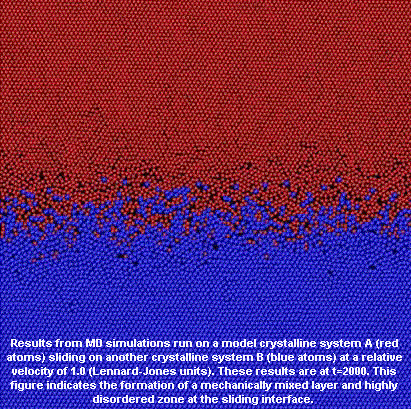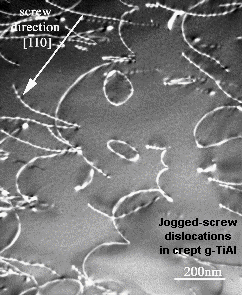| |
Past and Continuing Projects |
|
Dry
Sliding of Ductile Metals (2003-)
As a
postdoctoral researcher with
Prof.
David Rigney, I tried to understand
interfacial processes that lead to the
formation of nanocrystalline, mechanically-mixed tribomaterial during sliding,
particularly at high velocities. The formation of tribomaterial has important
implications on the transient friction and wear response of th e tribopair. To
answer these issues, we did Molecular Dynamics (MD) simulations of sliding in
amorphous and crystalline systems. We discovered that tribomaterial is formed
mainly due to fluid-like plastic flow at the sliding interface, with features
strongly reminiscent of
“vorticity”. This behavior has been observed in both crystalline and
amorphous systems.
e tribopair. To
answer these issues, we did Molecular Dynamics (MD) simulations of sliding in
amorphous and crystalline systems. We discovered that tribomaterial is formed
mainly due to fluid-like plastic flow at the sliding interface, with features
strongly reminiscent of
“vorticity”. This behavior has been observed in both crystalline and
amorphous systems.
I also
attempted to model velocity, strain-rate and strain gradients that develop
adjacent to the sliding surface based on fluid flow principles. We developed
analytical models for determining the high velocity friction. We are currently
tring to verify these models by characterization of near-surface deformation
structures using Transmission Electron Microscopy. We believe that MD
simulations can also aid in the understanding of the fundamental friction-related processes, particularly at high
velocities. This research is a collaboration between Ohio State and Los
Alamos National Labs, where they have built a new Rotating Barrel Gas Gun (RBGG)
that enables the dynamic measurement of high sliding velocity (1-10 m/s), and in
addition could help probe the synergistic effect of high velocity impact.
I was
involved in the building of an intermediate speed pin-on-disc tribometer with
capabilities for testing in air, nitrogen and high vacuum and for rapid data
acquisition. The samples tested with this equipment at Ohio State are being
characterized presently.
Modeling
Microtwinning in Ni-based disc alloys (2003- )
Electron
microscopy has confirmed that high temperature creep (over a given window of
stress and temperature) in some Ni-based disc alloys is dominated by a
microtwinning mechanism - something not usually expected under creep conditions.
I
 worked
with
Prof.
Mike Mills, to understand microtwinning in Ni-based disc alloys under creep
conditions. As part of this work, wesimulated various defects such as
superlattice stacking faults and twins and calculated their energies using EAM
potentials. We employed Monte Carlo methods to probe the reordering that occurs
during microtwinning in these alloys. We also developed a simple creep model
based on such reordering.
worked
with
Prof.
Mike Mills, to understand microtwinning in Ni-based disc alloys under creep
conditions. As part of this work, wesimulated various defects such as
superlattice stacking faults and twins and calculated their energies using EAM
potentials. We employed Monte Carlo methods to probe the reordering that occurs
during microtwinning in these alloys. We also developed a simple creep model
based on such reordering.
Understanding Creep Behavior and Microstructural Stability of g-TiAl alloys
(1997- )
For my PhD, I
worked with
Prof.
Mike Mills to understand creep deformation, and microstructural
and alloying effects in gamma titanium aluminide alloys which have potential
high temperature structural applications. To this effect, we carried out high
temperature constant strain-rate and creep testing of these alloys in different
microstructures. Deformation microstructures were characterized using techniques
including TEM. We subsequently developed a physically-based dislocation-level
creep model based on the jogged-screw mechanism and which is substantiated by microstructural
observations. We also did dynamic simulation
of jogged-screw dislocation motion based a line-tension model. This model was
subsequently modified to not only account for microstructure (Equiaxed Vs. Fully
lamellar), but also adapted for other materials systems including titanium and
a-Zr alloys. Extensive studies, utilizing conventional TEM tools were carried
out to investigate the thermal stability in
-TiAl alloys, particularly in the fully lamellar microstructure.
 e tribopair. To
answer these issues, we did Molecular Dynamics (MD) simulations of sliding in
amorphous and crystalline systems. We discovered that tribomaterial is formed
mainly due to fluid-like plastic flow at the sliding interface, with features
strongly reminiscent of
“vorticity”. This behavior has been observed in both crystalline and
amorphous systems.
e tribopair. To
answer these issues, we did Molecular Dynamics (MD) simulations of sliding in
amorphous and crystalline systems. We discovered that tribomaterial is formed
mainly due to fluid-like plastic flow at the sliding interface, with features
strongly reminiscent of
“vorticity”. This behavior has been observed in both crystalline and
amorphous systems. worked
with
worked
with